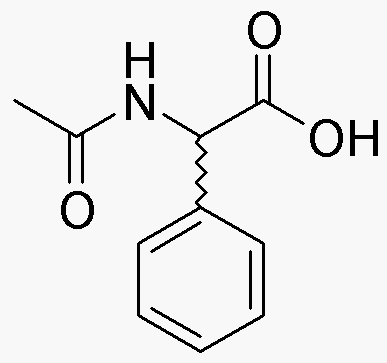Acetyl-DL-phenylglycine is widely utilized in research focused on:
- Pharmaceutical Development: This compound serves as an important intermediate in the synthesis of various pharmaceuticals, particularly those targeting pain relief and anti-inflammatory effects.
- Biochemical Research: It is used in studies investigating amino acid metabolism and protein synthesis, helping researchers understand metabolic pathways and their implications in health and disease.
- Analytical Chemistry: Acetyl-DL-phenylglycine is employed as a standard in chromatographic techniques, aiding in the accurate quantification of related compounds in complex mixtures.
- Food Industry: This compound finds applications in flavor enhancement and preservation, contributing to the development of food additives that improve taste and shelf-life.
- Cosmetic Formulations: It is incorporated into skincare products for its potential benefits in skin hydration and soothing properties, making it valuable in the cosmetic industry.
General Information
Properties
Safety and Regulations
Applications
Acetyl-DL-phenylglycine is widely utilized in research focused on:
- Pharmaceutical Development: This compound serves as an important intermediate in the synthesis of various pharmaceuticals, particularly those targeting pain relief and anti-inflammatory effects.
- Biochemical Research: It is used in studies investigating amino acid metabolism and protein synthesis, helping researchers understand metabolic pathways and their implications in health and disease.
- Analytical Chemistry: Acetyl-DL-phenylglycine is employed as a standard in chromatographic techniques, aiding in the accurate quantification of related compounds in complex mixtures.
- Food Industry: This compound finds applications in flavor enhancement and preservation, contributing to the development of food additives that improve taste and shelf-life.
- Cosmetic Formulations: It is incorporated into skincare products for its potential benefits in skin hydration and soothing properties, making it valuable in the cosmetic industry.
Documents
Safety Data Sheets (SDS)
The SDS provides comprehensive safety information on handling, storage, and disposal of the product.
Product Specification (PS)
The PS provides a comprehensive breakdown of the product’s properties, including chemical composition, physical state, purity, and storage requirements. It also details acceptable quality ranges and the product's intended applications.
Certificates of Analysis (COA)
Search for Certificates of Analysis (COA) by entering the products Lot Number. Lot and Batch Numbers can be found on a product’s label following the words ‘Lot’ or ‘Batch’.
*Catalog Number
*Lot Number
Certificates Of Origin (COO)
This COO confirms the country where the product was manufactured, and also details the materials and components used in it and whether it is derived from natural, synthetic, or other specific sources. This certificate may be required for customs, trade, and regulatory compliance.
*Catalog Number
*Lot Number
Safety Data Sheets (SDS)
The SDS provides comprehensive safety information on handling, storage, and disposal of the product.
DownloadProduct Specification (PS)
The PS provides a comprehensive breakdown of the product’s properties, including chemical composition, physical state, purity, and storage requirements. It also details acceptable quality ranges and the product's intended applications.
DownloadCertificates of Analysis (COA)
Search for Certificates of Analysis (COA) by entering the products Lot Number. Lot and Batch Numbers can be found on a product’s label following the words ‘Lot’ or ‘Batch’.
*Catalog Number
*Lot Number
Certificates Of Origin (COO)
This COO confirms the country where the product was manufactured, and also details the materials and components used in it and whether it is derived from natural, synthetic, or other specific sources. This certificate may be required for customs, trade, and regulatory compliance.


